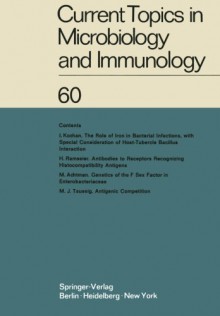Current Topics in Microbiology and Immunology: Ergebnisse der Mikrobiologie und Immunitätsforschung
The study of the genetic regulation of immune response to natural multidetermi nant immunogens was undertaken by the method of bidirectional selective breed ing of High or Low antibody responder lines of mice. Five Selections are described: Selection I, carried out for agglutinin responsiveness...
show more
The study of the genetic regulation of immune response to natural multidetermi nant immunogens was undertaken by the method of bidirectional selective breed ing of High or Low antibody responder lines of mice. Five Selections are described: Selection I, carried out for agglutinin responsiveness to sheep erythrocytes and pigeon erythrocytes alternated in each generation. Selection II, carried out for agglutinin responsiveness to sheep erythrocytes repeated in each generation. Selection III and Selection IV performed respectively for agglutinin response to flagellar or somatic antigens of Salmonella typhimurium and Salmonella oranienburg alternated in each generation. Selection V, performed for passive agglutinin response to bovine serum albumin and rabbit gamma globulin alternated in each generation. In each Selection the character investigated is polygenic. High and Low responder lines diverge progressively during the selective breeding. The maximal interline separation (selection limit) is reached in the 7th-16th generations. High and Low responder lines at selection limit are considered homozygous for the character submitted to se~ection. Their variance is therefore only due to environ mental effects. The difference in agglutinin titre between High and Low lines is 220-fold in Selection I, 103-fold in Selection II, 90-fold in Selection III, 85-fold in Selection IV and 275-fold in Selection V. The partition of genetic and environmental variances in the foundation popu lations of the five Selections is established. The proportion of genetic variance is 60% in Selection I; 49% in Selection II; 51% in Selection III; 47% in Selection IV and 76% in Selection V.
show less
Format: Paperback
ISBN:
9783642655043 (3642655041)
ASIN: 3642655041
Publish date: 2011-11-11
Publisher: Springer
Pages no: 209
Edition language: English

